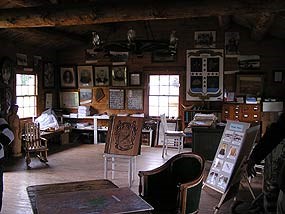
NPS/Meg Scheid Mid-June to early September: Wednesday through Sunday, 11 a.m.-4 p.m. Madawaska Historical Society Acadian Landing Site Acadian Cross Historic Shrine, a 14 foot marble cross represents the first cross erected in 1785 by the first Acadians settlers who set foot in the valley after canoeing up the St. John River. The cross represents their gratitude for their safe haven and a land of their own. Today some religious and ceremonial services are occasionally held at the site. It is owned by the Madawaska Historical Society. Tante Blanche Museum Fred Albert House The Fred Albert House once stood in Madawaska on the St. John River. Last occupied in 1970, the house was dedicated as a museum in 1990. Its architectural characteristics suggest that Luke Albert (1818–1888) or his father, Anselme Albert, was the builder. François Albert Jr. and his wife Marie Anne moved to the Madawaska territory from Quebec. As early settlers they had an opportunity to choose their land, and were able to secure property along a brook that had potential as a mill site. The deed that transfers the property from François Albert Jr. to his son Anselme makes it clear that the family was living there by 1806. The one‑and‑a‑half‑story Albert House has the typical Georgian proportions and square‑hewn log (pièce‑sur‑pièce) wall construction of other 19th‑century houses in the valley. In the house, pièce‑sur‑pièce à tenons en coulisse wall construction is combined with half‑dovetail joinery at the corners. The Albert House appears to have had only a central chimney. Like many other upper St. John Valley houses of the mid‑19th century, the Albert House has ship knees fitted into the attic. Madawaska School District No. 1 When the school closed in 1930 the schoolhouse fell into disrepair. In 1976 the Madawaska Historical Society moved it three miles north to its present location. Today the interior is furnished with artifacts, textbooks, and basic teaching aids of the period, as well as the original wooden blackboard. |
Last updated: April 9, 2013
